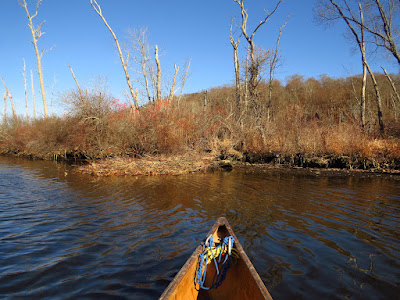I put in at the Coginchaug site, mostly because it got me off of the highway sooner as all of the holiday travels seemed to be bound and determined to crash into each other, and a few of them have succeeded. My start from home was delayed due to a medium sized Hawk that was trying to flush a squirrel from an evergreen in our back yard. The cats found this especially entertaining, and I did not want to interfere.
The tide is coming in and with that and the recent heavy rain, the river is running at about a normal level. It is under 40F, mostly sunny and with a light cool wind. I came here because the weather prediction is for a gusty afternoon, and the Mattebasset is fairly protected from wind.
I head down the Cog- and turn up the Matt-. I am immediately pleased that I decided to canoe today. It is a beautiful day with spectacular light.
There is a Red Throated Loon in the open marsh. For me, this is a come Spring sighting as they take a break while heading south. This might be the first time that I've seen one in the Fall.
A report on the beaver colonies -
The Big Lodge is clearly abandoned and collapsing.
The bank burrow near the ruins of the Tepee Lodge is in use.
Point Lodge is the star of the show. It is well maintained with lots of sign all around it. There are several trees partially cut, and a few more that have been felled.
Heading up from there, the last tree gnaw is about a 100 yards away. Then there is a gap of no sign for the next hundred yards, at which point there are numerous scent mounds - about 75 feet apart - maybe 8 or 10 total. The left bank, where the mounds are, is actually a berm between the river and a large open marsh. I suspect that there is a lodge back in that marsh, and these are the colony's territorial mounds.
The bank burrow at the next bend is in use with a few signs nearby.
I continue up another mile past the upper put-in, getting to the sandbar section. I turn back wanting some time to look up the Cognichaug. Spot 2 kayakers on the way down, and Outrigger Guy passes me while I make notes.
I get up to the powerlines on the Cognichaug, passing two new lodges, which although modest, look like they are in use. With that, I head back out.





















